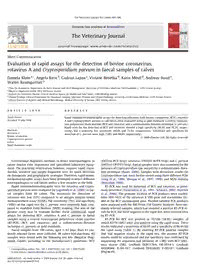
2009 Evaluation of rapid assays for the detection of bovine coronavirus, rotavirus A and Cryptosporidium parvum in faeca PDF
Preview 2009 Evaluation of rapid assays for the detection of bovine coronavirus, rotavirus A and Cryptosporidium parvum in faeca
Short Communication Evaluation of rapid assays for the detection of bovine coronavirus, rotavirus A and Cryptosporidium parvum in faecal samples of calves Daniela Klein a,*, Angela Kern b, Gudrun Lapan c, Viviane Benetka d, Karin Möstl d, Andreas Hassl e, Walter Baumgartner a a Clinic for Ruminants, Department for Farm Animals and Herd Management, University of Veterinary Medicine, Veterinaerplatz 1, 1210 Vienna, Austria b MegaCor Diagnostik GmbH, 6912 Hörbranz, Austria c Institute for Veterinary Disease Control, Austrian Agency for Health and Food Safety, 2340 Mödling, Austria d Clinical Virology, Clinical Department for Diagnostic Imaging, Infectious Diseases and Clinical Pathology, University of Veterinary Medicine, 1210 Vienna, Austria e Clinical Institute of Hygiene and Medical Microbiology, Medical University of Vienna, 1095 Vienna, Austria a r t i c l e i n f o Article history: Accepted 19 July 2008 Keywords: Rotavirus A Bovine coronavirus Cryptosporidium parvum Calves Rapid diagnostic assays a b s t r a c t Rapid immunochromatographic assays for detecting infections with bovine coronavirus (BCV), rotavirus A and Cryptosporidium parvum in calf faeces were evaluated using as gold standards a reverse transcrip- tase polymerase chain reaction (BCV and rotavirus) and a sedimentation-flotation technique (C. parvum). Rapid tests for the detection of BCV and rotavirus showed a high specificity (96.4% and 95.3%, respec- tively), but a relatively low sensitivity (60.0% and 71.9%, respectively). Sensitivity and specificity for detection of C. parvum were high (100% and 94.6%, respectively). � 2008 Elsevier Ltd. All rights reserved. Conventional diagnostic methods to detect enteropathogens in calves require time, experience and specialised laboratory equip- ment. The practising veterinarian, however, requires rapid, repro- ducible, sensitive and simple diagnostic tests for quick decisions on therapeutic and prophylactic strategies. Therefore, rapid immu- nochromatographic assays have been developed to detect different enteropathogens in calf faeces within a few minutes in the field. Rapid immunochromatographic tests for rotavirus and Crypto- sporidium parvum were evaluated by Luginbühl et al. (2005) in fae- cal samples from 60 calves. The sensitivity for detection of rotavirus was low (57%) compared to an antigen enzyme-linked immunosorbent assay (ELISA). The sensitivity (75%) and specificity (100%) of the rapid test for C. parvum were relatively high com- pared to modified Ziehl-Neelsen (MZN) staining. The aim of the present study was to evaluate further these commercial rapid assays for detecting BCV, rotavirus A and C. parvum in faecal samples using a reverse transcriptase polymerase chain reaction (RT-PCR) (BCV and rotavirus) and a sedimentation–flotation technique (C. parvum) as gold standards. Faecal samples from 180 calves, aged 1–42 days, from 61 ran- domly selected farms were collected; 98 calves had diarrhoea. All samples were tested with the following test kits (MegaCor Diag- nostik GmbH) according to the manufacturer’s guidelines: BCV (FASTest BCV Strip), rotavirus (FASTest ROTA Strip) and C. parvum (FASTest CRYPTO Strip). Faecal samples were also examined for the presence of Cryptosporidium spp. oocysts by a sedimentation–flota- tion technique (Bauer, 2006). Samples with discordant results for Cryptosporidium spp. were further tested using three different PCRs (Leng et al., 1996; Morgan et al., 1997, 1998) and MZN staining (Bronsdon, 1984). RT-PCR was used for detection of BCV and rotavirus, as previ- ously described (Tsunemitsu et al., 1991; Schwarz, 2002; Haschek et al., 2006). The genomic location of PCR products were nucleo- tides 589–1022 of the rotavirus A VP6 gene and nucleotides 92– 480 of the BCV nucleocapsid gene. Purified labelled PCR products were analysed with the ABI Prism 310 Genetic Analyser. Nine ran- domly selected samples, which had revealed a positive RT-PCR re- sult for BCV, but were negative in the rapid test, were retested once by RT-PCR. RT-PCR for BCV was positive in 70/180 (38.9%) samples, of which 42/70 (60%) were also positive using the rapid assay. These results indicated a sensitivity of 60.0% and a specificity of 96.4% for the rapid assay (Table 1). By retesting RT-PCR positive samples that had negative results in the rapid test, the positive RT-PCR results could be reproduced and the specificity was confirmed by sequencing. All sequences had identities of P98% with BCV refer- ence strains (DB2: GenBank DQ811784; OK-0514-3: GenBank AF058944; R-AH-187: GenBank EF424620; E-AH187: GenBank EF424619). 1090-0233/$ - see front matter � 2008 Elsevier Ltd. All rights reserved. doi:10.1016/j.tvjl.2008.07.016 * Corresponding author. Tel.: +43 1 250775207; fax: +43 1 250775290. E-mail address:
